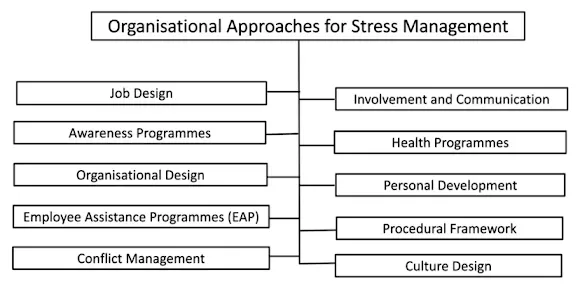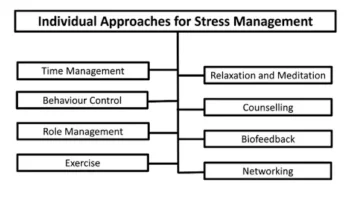Table of Contents:-
- Stress Management
- Individual Approaches for Stress Management
- Organisational Approaches for Stress Management
Stress Management
Stress management assists in overcoming stress and increases the levels of motivation and efficiency of the employees. It involves the recognition and analysis of problems related to stress. Further, it applies valuable tools to cither change the cause of stress or the occurrence of stress. These valuable tools are used in a unified and theoretically meaningful manner. The main objective of stress management is to motivate the individual to give his best performance, in a favourable environment and with a positive attitude.
Stress is inevitable in the life of an individual. Human beings are unable to remain stress-free, they have to face stress and find ways to handle it. Two approaches can help employees to deal with stress. These approaches operate at the individual level and organisational levels.
Individual Approaches for Stress Management
Individual approaches for stress management are as follows:

1) Time Management
This system is primarily used for setting objectives, planning and allocation of won It is believed that after the accomplishment of primary goals and plans, the secondary issues are unlikely to become the reasons for stress. The work of managers includes a constant cycle of many short activities. In this scenario, it is quite obvious that the managers are bound to pay attention to the latest issues and hence deviate from the main objectives, which becomes the root cause of stress. Setting objectives, planning and allocation of work helps to recognise the priority of every task.
2) Relaxation and Meditation
Performing activities related to one’s hobby or practising meditation and exercises may also help relieve stress. The basic concept behind practising these methods is stress can become a supporter of the individual. So, if a person involves himself in recreational activities will be soothing for the individual and bring about control in the life of the person.
3) Behaviour Control
This approach is very effective in subduing the situations that lead to stress. The person needs to recognise their behaviour and determine those situations that cause stress. In this way, they will be able to devise strategies to handle stress more efficiently in future.
4) Counselling
Counselling gives a chance an individual to freely discuss problems and devise new ways to deal with stress in the future. The employees, who have been subjected to some frightening experiences at the workplace, find it very difficult to go back to the same situation.
For example, bank employees who have witnessed an armed robbery at work may find it horrifying to recall the situation. Counselling can help individual reconcile their unpleasant experiences deal with stressful situations and live a tension-free life.
5) Role Management
Role management helps in controlling and reducing stress. For example, if an employee only focuses on his domestic problems and responsibilities and is unable to complete the task assigned by his senior, then this may lead to stress due to role conflict. This job-based stress can be handled very easily if the employee gives time to think over it and devises some alternate ways to handle this stress. He needs to learn about the causes of stress and bring about an alternative change in his work to manage both roles efficiently.
6) Biofeedback
Physical changes occur in the human body due to stress like an increase/decrease in a heartbeat and an increase in body temperature, etc. There are many ways through which body changes can be monitored and the individual can be imparted training to control the specific reactions, Thus, by managing biofeedback, the person can control the physical impact of stress.
7) Exercise
Regular exercise keeps the body fit and healthy. It also reduces weight and maintains overall fitness. Stress leads to offensive behaviour and annoyance which can be reduced through exercise. Physical exhaustion as a result of exercise also helps in sound sleep and makes a person relaxed.
8) Networking
Stressed people suffer from feelings of loneliness. They believe that they are the only people who are under stress and they turn their focus to their inner selves. The network group helps an individual to drive his focus outwards. Communicating with fellow professional workers, friends and other support providers (family is the foremost) results in projecting problems and devising innovative ways to deal with them. High expectations from oneself also make a person stressed.
Organisational Approaches for Stress Management
Approaches used by organisations to manage stress are as follows:

1) Job Design
The stress of a person can be reduced if attention is paid to job design. Good job design leaves a positive impact on employees’ mental and physical abilities. Hence, jobs should be designed in such a way that they are challenging and provide opportunities for employees to grasp new skills. Roles and responsibilities should be clearly defined so that occurrences of role conflict and role ambiguity can be minimised
2) Involvement and Communication
Employees who are part of the result-making process at the workplace, and who are well-versed with the organisation’s working can understand the importance of their role and hence remain aware and awaken to all the happenings around them. Thereupon, as a result of the lower level of ambiguity, some of the stress-leading possibilities are discarded, while some that still exist are reduced to manageable proportions.
3) Awareness Programmes
Awareness programmes like sensitivity training a technique that guides people and makes them sensitive about the presence of stress, reasons for stress and methods used to manage it.
Awareness programmes awaken people about stress openly, to find solutions to cope with it. The people, who come to know about stress and how to handle it, become able to make correct decisions associated with it and in their own life.
4) Health Programmes
This approach primarily focuses on devising health and development strategies for the improvement of health. The main objective of this approach is to provide innovative and specialised medical facilities to people to cope with stress.
5) Organisational Design
The physical and social layout within the organization also causes stress. Some customers horizontally observe an organisation while most organisations work vertically. This type of conflicting pressure produces stress on the employees who are associated with it. Therefore, there is a need for proper attention to the physical structuring to subdue the feeling of stress among the employees.
6) Personal Development
Vocational training and employment programmes help in personal development. If a person becomes more efficient, he will be less stressed in performing routine jobs. Hence, employees should be motivated towards acquiring new skills like learning another language or learning to play some musical instrument, etc. These activities provide a soothing and relaxing effect and bring about a balance in life hence resulting in the suppression of stress.
7) Employee Assistance Programmes (EAP)
This programme emphasises providing wide-range assistance to the employees at the workplace. This assistance is offered by some external organisations, which specialise in providing such services by phone. If an employee comes across a particular difficulty at the workplace, the problem can be solved instantly through telephonic interaction or even face-to-face meetings with the help of the support worker.
The main idea of providing EAPs is to assist the employee through non-company support. This is very beneficial for employees as they can quickly get their queries solved which consequently reduces the stress and obstacles affecting the employees’ performance. If an employee feels happy, the result is bound to be productive and beneficial to all.
8) Procedural Framework
Procedures give direction to the organisation. If the procedures are confusing or in conflict with one another, they will lose their importance and ultimately create stress. For example, if it is not known under what conditions the sales department can take an urgent order from an important customer and alter the production schedule then the risk of contradiction and chaos among all people will prevail.
9) Conflict Management
Conflict management does not guarantee that conflict can be removed permanently, but there is a possibility of its reduction and efficient management. An important method of conflict management is to identify the difference between competition and conflict. However, it is difficult to maintain a balance between competition and conflict, specifically when power and politics prevail in the organization. Thus, if efforts are made to maintain this balance, stress can be reduced to a substantial extent.
10) Culture Design
When a sympathetic culture is created in contrast to one based on power and politics, there are chances that the employees assist and cooperate. Such cooperation results in reduced stress. This will offer a supportive environment to individuals who are more susceptible to stress.
You May Also Like:-
Nature of Organisational Behaviour
Conceptual Foundation of Organisational Behaviour
Contributing Disciplines to organisational behaviour
Models of Organisational Behaviour
Approaches of Organisational Behaviour
Emotional Intelligence in Organisational behaviour
Factors Influencing Perception
Scope of Organisational Behaviour
Importance of Organisational Behaviour
Challenges and Opportunities of Organisational Behaviour
Factors affecting group behaviour
Causes of Conflict in an Organisation
Types of Conflict in an Organisation
Organisational Development Process
Factors Affecting Organisational Culture
